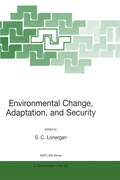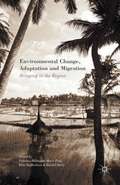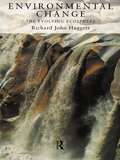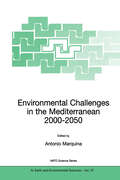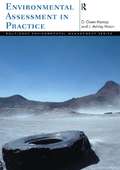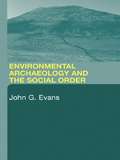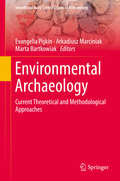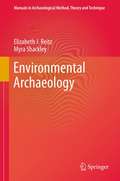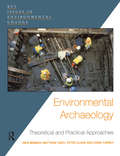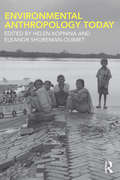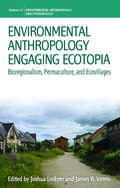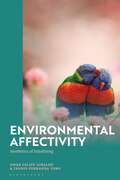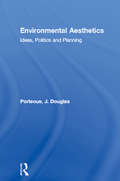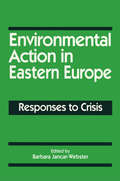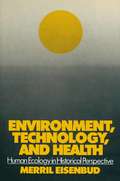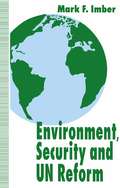- Table View
- List View
Environmental Change, Adaptation, and Security (NATO Science Partnership Subseries: 2 #65)
by S. LonerganThe chapters in this volume are edited versions of papers presented at the NATO Ad vanced Research Workshop on Environmental Change Adaptation and Security held in Budapest, Hungary, from October 16 - 18, 1997. As is evident in this volume, the papers ranged from descriptions of environmental and health issues in Russia and Eastern Europe to models of sustainable land use. This diversity of perspectives on environ ment and security is indicative of both the breadth of this new area of research as well as the varied background of the researchers involved. The discussions at the NATO workshop were remarkably animated and exciting, not surprising given the interest in the topic. I think this vitality is reflected in the papers in this volume as well. The main purpose of the NATO ARW is to foster research links among researchers from NATO countries and Central and Eastern European States, Russia, and the Newly Independent States. In editing this volume, a decision was made to keep to the spirit of this purpose and-if at all possible-include all papers prepared for the workshop. This required extensive editing and rewriting of some of the papers (and consequent delays in production). A determination was made early in the process by the workshop steering committee that the value of publishing the entire collection of articles out weighed the advantages of accepting only a limited number.
Environmental Change, Adaptation and Migration: Bringing in the Region
by Felicitas Hillmann Marie Pahl Birte Rafflenbeul Harald SterlyThe contributors present empirical and theoretical insights on current debates on environmental change, adaptation and migration. While focusing on countries subject to environmental degradation, it calls for a regional perspective that recognises local actors and a systematic link between development studies and migration research.
Environmental Change: The Evolving Ecosphere
by Richard HuggettEnvironmental Change explores the nature, causes, rates and directions of environmental change throughout earth history. Huggett introduces the interdependent parts of the natural environment - cosmic, ecological, geological - and the dynamic nature of the environmental system. Integrating a wealth of examples and illustrations from around the world, the book examines evidence and causes of change in life, climate (air and water), soils, sediments and landforms, and the impacts of human-environment interaction.
Environmental Change: The Evolving Ecosphere
by Richard HuggettEnvironmental Change explores the nature, causes, rates and directions of environmental change throughout earth history. Huggett introduces the interdependent parts of the natural environment - cosmic, ecological, geological - and the dynamic nature of the environmental system. Integrating a wealth of examples and illustrations from around the world, the book examines evidence and causes of change in life, climate (air and water), soils, sediments and landforms, and the impacts of human-environment interaction.
Environmental Challenges in the Mediterranean 2000–2050: Proceedings of the NATO Advanced Research Workshop on Environmental Challenges in the Mediterranean 2000–2050 Madrid, Spain 2–5 October 2002 (NATO Science Series: IV: #37)
by AntonioMarquinaThis book addresses six key factors that will affect environmental policies in the Mediterranean region during the next fifty years: population growth, climate change, soil erosion and desertification, water scarcity, food production, and urbanization and pollution. The authors assess these as potential sources of violent conflict. The interdisciplinary approach makes this a relevant and useful reference for a broad range of professionals, specialists and researchers.
Environmental Assessment in Practice (Routledge Environmental Management)
by Owen Harrop Ashley NixonThis text explains what constitutes good practice in applying environmental assessment as an environmental management tool. A wide range of case studies and other student text features are employed to demonstrate how the different methods, techniques and disciplines of environmental assessment can be used. The authors address the key concepts for environmental assessment procedures: methods for using E.A.; techniques for impact prediction and evaluation; environmental risk assessment; EA consultation and participation; project management; environmental statement review and post-project analysis; and strategic environmental assessment.Worldwide case studies include: gas pipelines, hydroelectric power plants, gold mining, river crossings, waste-to-energy plants and gravel extraction in England, Scotland, Ireland, Canada, the USA, Venezuela, the Netherlands, Iceland, Zambia, Zimbabwe, South Africa and Ghana.
Environmental Assessment in Practice (Routledge Environmental Management)
by Owen Harrop Ashley NixonThis text explains what constitutes good practice in applying environmental assessment as an environmental management tool. A wide range of case studies and other student text features are employed to demonstrate how the different methods, techniques and disciplines of environmental assessment can be used. The authors address the key concepts for environmental assessment procedures: methods for using E.A.; techniques for impact prediction and evaluation; environmental risk assessment; EA consultation and participation; project management; environmental statement review and post-project analysis; and strategic environmental assessment.Worldwide case studies include: gas pipelines, hydroelectric power plants, gold mining, river crossings, waste-to-energy plants and gravel extraction in England, Scotland, Ireland, Canada, the USA, Venezuela, the Netherlands, Iceland, Zambia, Zimbabwe, South Africa and Ghana.
Environmental Archaeology: Meaning and Purpose (Environmental Science and Technology Library #17)
by UmbertoAlbarellaDespite the fact that the human life of the past cannot be understood without taking into account its ecological relationships, environmental studies are often marginalized in archaeology. This is the first book that, by discussing the meaning and purpose we give to the expression `environmental archaeology', investigates the reasons for such a problem. The book is written in an accessible manner and is of interest to all students who want to understand the essence of archaeology beyond the boundary of the individual subdisciplines.
Environmental Archaeology and the Social Order
by John G. EvansPresenting a wide variety of case studies, ranging from the early Palaeolithic to Post-modernity, and from Europe to the Andes, West and East Africa, and the USA, Environmental Archaeology and the Social Order deals with both the theory and method of environmental archaeology. Including significant sections on Neanderthals, Palaeolithic mobiliary art and the origins of farming, as well as transhumance, climate as social construct, field survey and the place of documents in environmental research, Professor Evans interprets his findings in social constructionist terms, creating an important argument against the use of traditional materialist and processualist paradigms. This original and controversial volume sets a new agenda for the study and understanding of environmental archaeology, and will prove an informative and useful purchase.
Environmental Archaeology and the Social Order
by John G. EvansPresenting a wide variety of case studies, ranging from the early Palaeolithic to Post-modernity, and from Europe to the Andes, West and East Africa, and the USA, Environmental Archaeology and the Social Order deals with both the theory and method of environmental archaeology. Including significant sections on Neanderthals, Palaeolithic mobiliary art and the origins of farming, as well as transhumance, climate as social construct, field survey and the place of documents in environmental research, Professor Evans interprets his findings in social constructionist terms, creating an important argument against the use of traditional materialist and processualist paradigms. This original and controversial volume sets a new agenda for the study and understanding of environmental archaeology, and will prove an informative and useful purchase.
Environmental Archaeology: Current Theoretical and Methodological Approaches (Interdisciplinary Contributions to Archaeology)
by Evangelia Pişkin Arkadiusz Marciniak Marta BartkowiakThis book aims to thoroughly discuss new directions of thinking in the arena of environmental archaeology and test them by presenting new practical applications.Recent theoretical and epistemological advancement in the field of archaeology calls for a re-definition of the subdiscipline of environmental archaeology and its position within the practise of archaeology. New technological and methodological discoveries in hard sciences and computer applications opened fresh ways for interdisciplinary collaborations thus introducing new branches and specialisations that need now to be accommodated and integrated within the previous status-quo.This edited volume will take the challenge and engage with contemporary international discussions about the role of the discipline within the general framework of archaeology. By drawing upon these debates, the contributors to this volume will rethink what environmental archaeology is and what kind of input the investigation of this kind of materiality has to the reconstruction of human history and sociality.
Environmental Archaeology (Manuals in Archaeological Method, Theory and Technique)
by Elizabeth Reitz Myra ShackleyOne of the most significant developments in archaeology in recent years is the emergence of its environmental branch: the study of humans’ interactions with their natural surroundings over long periods and of organic remains instead of the artifacts and household items generally associated with sites. With the current attention paid to human responsibility for environmental change, this innovative field is recognized by scientists, conservation and heritage managers and policymakers worldwide. In this context comes Environmental Archaeology by Elizabeth Reitz and Myra Shackley, updating the seminal 1981 text Environmental Archaeology by Myra Shackley. Rigorously detailed yet concise and accessible, this volume surveys the complex and technical field of environmental archaeology for researchers interested in the causes, consequences and potential future impact of environmental change and archaeology. Its coverage acknowledges the multiple disciplines involved in the field, expanding the possibilities for using environmental data from archaeological sites in enriching related disciplines and improving communication among them. Introductory chapters explain the processes involved in the formation of sites, introduce research designs and field methods and walk the reader through biological classifications before focusing on the various levels of biotic and abiotic materials found at sites, including: Sediments and soils. Viruses, bacteria, archaea, protists and fungi. Bryophytes and vascular plants. Wood, charcoal, stems, leaves and roots. Spores, pollen and other microbotanical remains. Arthropods, molluscs, echinoderms and vertebrates. Stable isotopes, elements and biomolecules. The updated Environmental Archaeology is a major addition to the resource library of archaeologists, environmentalists, historians, researchers, policymakers—anyone involved in studying, managing or preserving historical sites. The updated Environmental Archaeology is a major addition to the resource library of archaeologists, environmentalists, historians, researchers, policymakers—anyone involved in studying, managing, or preserving historical sites.
Environmental Archaeology: Theoretical and Practical Approaches (Key Issues in Environmental Change)
by Chris Turney Matthew Canti Nick Branch Peter ClarkEnvironmental Archaeology: Theoretical and Practical Approaches outlines and assesses the various methods used to reconstruct and explain the past interaction between people and their environment. Emphasising the importance of a highly scientific approach to the subject, the book combines geoarchaeological, bioarchaeological (archaeobotany and zooarchaeology) and geochronological information and examines how these various aspects of archaeology may be used to enhance our knowledge and understanding of past human environments. Drawing from both the practical experiences of the authors and cutting-edge research, Environmental Archaeology: Theoretical and Practical Approaches is a valuable contribution to the subject. It will be essential reading for students and professionals in archaeology, geography and anthropology.
Environmental Archaeology: Theoretical and Practical Approaches (Key Issues in Environmental Change)
by Chris Turney Matthew Canti Nick Branch Peter ClarkEnvironmental Archaeology: Theoretical and Practical Approaches outlines and assesses the various methods used to reconstruct and explain the past interaction between people and their environment. Emphasising the importance of a highly scientific approach to the subject, the book combines geoarchaeological, bioarchaeological (archaeobotany and zooarchaeology) and geochronological information and examines how these various aspects of archaeology may be used to enhance our knowledge and understanding of past human environments. Drawing from both the practical experiences of the authors and cutting-edge research, Environmental Archaeology: Theoretical and Practical Approaches is a valuable contribution to the subject. It will be essential reading for students and professionals in archaeology, geography and anthropology.
Environmental Anthropology Today
by Helen Kopnina Eleanor Shoreman-OuimetToday, we face some of the greatest environmental challenges in global history. Understanding the damage being done and the varied ethics and efforts contributing to its repair is of vital importance. This volume poses the question: What can increasing the emphasis on the environment in environmental anthropology, along with the science of its problems and the theoretical and methodological tools of anthropological practice, do to aid conservation efforts, policy initiatives, and our overall understanding of how to survive as citizens of the planet? Environmental Anthropology Today combines a range of new ethnographic work with chapters exploring key theoretical and methodological issues, and draws on disciplines such as sociology and environmental science as well as anthropology to illuminate those issues. The case studies include work on North America, Europe, India, Africa, Asia, and South America, offering the reader a stimulating and thoughtful survey of the work currently being conducted in the field.
Environmental Anthropology Today
by Helen Kopnina Eleanor Shoreman-OuimetToday, we face some of the greatest environmental challenges in global history. Understanding the damage being done and the varied ethics and efforts contributing to its repair is of vital importance. This volume poses the question: What can increasing the emphasis on the environment in environmental anthropology, along with the science of its problems and the theoretical and methodological tools of anthropological practice, do to aid conservation efforts, policy initiatives, and our overall understanding of how to survive as citizens of the planet? Environmental Anthropology Today combines a range of new ethnographic work with chapters exploring key theoretical and methodological issues, and draws on disciplines such as sociology and environmental science as well as anthropology to illuminate those issues. The case studies include work on North America, Europe, India, Africa, Asia, and South America, offering the reader a stimulating and thoughtful survey of the work currently being conducted in the field.
Environmental Anthropology Engaging Ecotopia: Bioregionalism, Permaculture, and Ecovillages (Environmental Anthropology and Ethnobiology #17)
by Joshua Lockyer James R. VetetoIn order to move global society towards a sustainable “ecotopia,” solutions must be engaged in specific places and communities, and the authors here argue for re-orienting environmental anthropology from a problem-oriented towards a solutions-focused endeavor. Using case studies from around the world, the contributors—scholar-activists and activist-practitioners— examine the interrelationships between three prominent environmental social movements: bioregionalism, a worldview and political ecology that grounds environmental action and experience; permaculture, a design science for putting the bioregional vision into action; and ecovillages, the ever-dynamic settings for creating sustainable local cultures.
Environmental Affectivity: Aesthetics of Inhabiting
by Dr Omar Felipe Giraldo Ms Ingrid Fernanda ToroFollowing Spinoza's lead and Latin American environmental thought, this book imagines an embodied environmental ethics based on the relations between sentient beings and sustained by affections, sensibility, the senses, and contact. Engaging embodied, cognitive, phenomenological, aesthetic and psychoanalytic aspects of affectivity, Omar Felipe Giraldo and Ingrid Fernanda Toro help us understand how places inhabit us, and therefore, how places transformed lovingly have the immense capacity to modify the body, to redirect desire, to clarify our sensibility – creating an affectivity in direction opposition to the regime imposed by this global ecocidal capitalism.For the authors, the environmental crisis is more than a technological or economic problem. They see it as a threat to survival inscribed in the deepest foundations of our body, in the intimacy of our skin, in the intensity and tone of our affections, in our desires, in our perceptions and in our sensory-motor capacities. Hence, the immense need to dismantle this system of power embedded in the intimacy of our body and to cultivate a perceptual transformation guided by an empathic knowledge that leads to a different understanding of our belonging in that which exceeds us. This book is a vital manifesto on the political role of affects, an invitation to awaken the sensitive perception anesthetized by the ecologies of cruelty, and an urgent call to understand differently our place in the cosmos in the midst of this war that our civilization has declared on life.
Environmental Affectivity: Aesthetics of Inhabiting
by Dr Omar Felipe Giraldo Ms Ingrid Fernanda ToroFollowing Spinoza's lead and Latin American environmental thought, this book imagines an embodied environmental ethics based on the relations between sentient beings and sustained by affections, sensibility, the senses, and contact. Engaging embodied, cognitive, phenomenological, aesthetic and psychoanalytic aspects of affectivity, Omar Felipe Giraldo and Ingrid Fernanda Toro help us understand how places inhabit us, and therefore, how places transformed lovingly have the immense capacity to modify the body, to redirect desire, to clarify our sensibility – creating an affectivity in direction opposition to the regime imposed by this global ecocidal capitalism.For the authors, the environmental crisis is more than a technological or economic problem. They see it as a threat to survival inscribed in the deepest foundations of our body, in the intimacy of our skin, in the intensity and tone of our affections, in our desires, in our perceptions and in our sensory-motor capacities. Hence, the immense need to dismantle this system of power embedded in the intimacy of our body and to cultivate a perceptual transformation guided by an empathic knowledge that leads to a different understanding of our belonging in that which exceeds us. This book is a vital manifesto on the political role of affects, an invitation to awaken the sensitive perception anesthetized by the ecologies of cruelty, and an urgent call to understand differently our place in the cosmos in the midst of this war that our civilization has declared on life.
Environmental Aesthetics: Ideas, Politics and Planning
by J. Douglas PorteousFirst published in 2004. Routledge is an imprint of Taylor & Francis, an informa company.
Environmental Aesthetics: Ideas, Politics and Planning
by J. Douglas PorteousFirst published in 2004. Routledge is an imprint of Taylor & Francis, an informa company.
Environmental Action in Eastern Europe: Responses to Crisis
by Barbara Jancar-WebsterThe environmental crisis in Eastern Europe - air and water pollution, toxic waste dumps, and unsafe nuclear facilities - has been vividly documented since the revolution of 1989. Not only did the communist states have an abysmal record of environmental destruction, but the issue of environmental protection and safety proved to be one of the msot powerful catalysts of unified opposition to these regimes. This collection of essays by both Western and East European experts examines the efforts to develop strategies for dealing with the crisis, both by governments and at the grassroots level of newly emerging Green movements. Among the countries represented here are Poland, Hungary, Czechoslovakia, Lithuania, Slovenia and the Commonwealth of Independent States.
Environmental Action in Eastern Europe: Responses to Crisis
by Barbara Jancar-WebsterThe environmental crisis in Eastern Europe - air and water pollution, toxic waste dumps, and unsafe nuclear facilities - has been vividly documented since the revolution of 1989. Not only did the communist states have an abysmal record of environmental destruction, but the issue of environmental protection and safety proved to be one of the msot powerful catalysts of unified opposition to these regimes. This collection of essays by both Western and East European experts examines the efforts to develop strategies for dealing with the crisis, both by governments and at the grassroots level of newly emerging Green movements. Among the countries represented here are Poland, Hungary, Czechoslovakia, Lithuania, Slovenia and the Commonwealth of Independent States.
Environment, Technology, and Health: Human Ecology in Historical Perspective (pdf)
by Merril EisenbudEnvironment, Security and UN Reform
by M. ImberThis book presents a study of international relations theory and the role of the United Nations in international environmental negotiations. The book links discussion of three issues: the persistence of third-world debt, the environmental abuse of the global commons and the financial and institutional crises within the UN system. It includes a summary of both the achievements and limitations of the 1992 Rio Summit, (UNCED), and concludes with far reaching proposals for the restructuring of UN activities.
